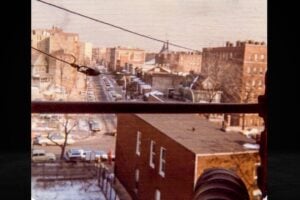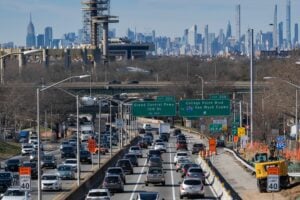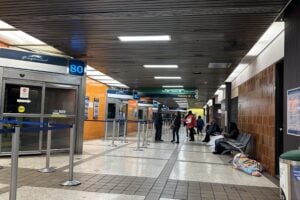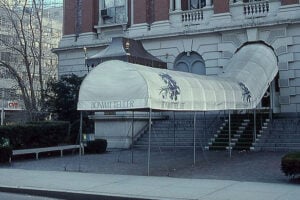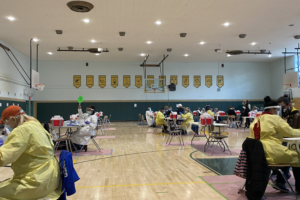
Feature Photo: iofoto / Shutterstock
The harbor belonging to New York City’s Narrows features the Verrazzano-Narrows Bridge as a span between Brooklyn and Staten Island. It connects the two boroughs as more than just an example of mankind’s handiwork. It also serves as an unofficial welcome to seafaring traffic coming in from as far away as the Atlantic Ocean. This thirteen-lane double-decker bridge currently serves as part of the Interstate 278 highway where seven of them are on the upper level and six are on the lower level. What some people may see as a simple bridge stretching high across a body of water, others see it as an important piece of history that makes New York City what it is.
What this bridge accomplished was making Staten Island feel more like it’s a part of the city as a borough instead of an isolated island that has no real connection. As New York embarked on its ambitious development to accommodate the surge of immigration of citizens pouring in from across the Atlantic, the importance of this bridge enabled this city to grow in every direction. The heavy usage of the bridge across the Narrows has demonstrated this over the years.
Plans & Proposals
The proposal of this historic bridge began in 1926 with engineer David B. Steinman as he wanted to build something across the Narrows that would make travel between Brooklyn and Staten Island easier. However, this wouldn’t be further looked into for at least two decades.
It was his idea to connect Staten Island with the rest of New York City. At the time, this was the most isolated borough that could only be accessed by ferries. In 1928, the chambers of commerce belonging to Brooklyn, Long Island, Queens, and Staten Island made an announcement the Interboro Bridge Company proposed the construction of Liberty Bridge to the United States Department of War.
The bridge’s towers were proposed to stand as tall as eight hundred feet high with an estimated cost of sixty million dollars. In 1929, the engineers revealed plans for the 4,500-foot-long bridge that would span across the Narrows, using the towers to suspend it above the waters. There was hope the project proposal would spark interest in Staten Island’s development as the Bayonne Bridge and Outerbridge Crossing were already underway at the time. The idea was the proposed Liberty Bridge would cater to vehicles traveling from Bay Ridge, Brooklyn to a chosen destination on the island.
From Brooklyn, the bridge was considered to serve as a crosstown highway that would connect it and Queens to the proposed Triborough Bridge. There was also the idea to connect Liberty Bridge to Manhattan Bridge which was already connecting downtown Brooklyn to lower Manhattan.
Tunneling Possibilities
Prior to the bridge proposal, there was an attempt to build the Staten Island Tunnel but that came to a halt in 1925, two years after it was conceived as a project. The idea was to connect the tunnel to the New York City Subway service so that it would include Staten Island.
When Steinman’s 1926 proposal was put on the table, this revived interest in the Staten Island Tunnel. At the same time, there was also a project proposal for vehicular tunnels that would allow travelers to drive between Fort Wadsworth, Staten Island to 97th Street, Brooklyn. The idea was to build tubes in conjunction with Triborough Tunnel and its connection between connecting Brooklyn, Manhattan, and Queens. This proposal met with approval and the city pledged five million dollars in 1929 to begin the tunnels.
The Baltimore and Ohio Railroad also took part as a financial backer. The planners wasted no time getting to work once it appeared this project was destined to move forward. However, the Brooklyn Chamber of Commerce looked into this project, as well as the other two that were presented. Between the bridge, subway tunnel, and vehicular tunnel, there were discussions to determine which among them was the best option. Interested groups from both sides of the Narrows couldn’t reach an agreement on the matter.
The residents of Bay Ridge didn’t care for the bridge idea as it meant parts of the community would need to be demolished in order to construct it. Because of this, work began on the favored vehicular tunnel idea in November 1930. The idea was to build twin tunnels measuring eleven thousand feet that would connect Staten Island’s Hylan Boulevard with Brooklyn’s 86th Street. The plan was to have the construction of this tunnel completed by 1937. However, the work itself didn’t extend beyond the examination of Brooklyn’s shoreline.
Blockages
Even after the U.S. House of Representatives approved a bill in February 1933 that authorized the construction of a suspension bridge across the Narrows, the War Department felt the bridge idea was a mistake. It made its official announcement against it in April 1934. Doing so had private interests look into tunneling possibilities instead. Going into 1936, the discussion of the bridge crossing the Narrows came up again when New York City’s mayor at the time, Fiorello H. La Guardia, gained the authority to petition the U.S. Congress for its potential development.
At the time, there was a new plan in place that saw a toll that would charge motorists each time they crossed it. However, La Guardia had a preference for the tunnel proposal instead. In 1937, he asked the New York City Tunnel Authority to consider it as the crossing of choice across the Narrows. This resulted in a plan that was brought forth in 1939 that would expand the city’s highway system. It was the same year the bill for Battery Bridge was passed as a last-minute amendment to the bill added by state legislators. Staten Island was under the impression this would be part of the Narrows bridge plan.
At the same time, Bay Ridge residents also opposed the tunneling idea as they felt this would compromise the neighborhood’s quality of living. When it came down to voting on both the bridge and tunnel proposals they were blocked by La Guardia who felt now wasn’t the time to allow such projects to move forward.
Revivals
As fate had it, the cancellation of the tunnel for the Narrows revived the proposals of a bridge again that would be led by Robert Moses as chairman of the Triborough Bridge and Tunnel Authority. In 1948, the War Department was asked for permission to build the bridge across the Narrows after Moses came up with a plan that was more appealing than the attempts made by his predecessors. However, Donald Lawrence O’Toole sided with his Bay Ridge constituents that the bridge was a bad idea. Not only would it diminish the character of the area but cause a blockage in the Narrows should another military conflict erupt. According to his polls, there were more against the construction of the bridge than for it.
As it turned out, the United States military approved the bridge idea in 1949 despite Bay Ridge’s opposition. However, conditions had it that it needed to begin construction in five years or less. Even though it was approved to move forward, the finances needed to fund the project had to wait until 1950 when the Battery Tunnel was completed.
Going into 1954, Moses and acting Port Authority Chairman Bayard F. Pope agreed to use their agencies to build and operate the proposed Narrows Bridge. However, actual construction couldn’t begin until at least 1957 due to bondholder-related restrictions that were still in place. This resulted in the city’s approved request from the Army for a two-year extension.
Aside from the mixed reaction to the bridge, it was concluded it was a necessity in order to ensure Staten Island’s future. After some political chess play, the Port Authority was granted permission to build the bridge under the agreement the TBTA would operate it. In 1967, the bridge was sold to TBTA as part of the agreement.
Political Chess Matches
Originally, the Narrows Bridge was supposed to connect Brooklyn’s Circumferential Parkway but that decision was vetoed in 1957. As a result, the new location was decided to be at Fort Lafayette, the coastal destination built next to Fort Hamilton at the southern tip of Bay Ridge.
It wasn’t until 1959 the political chess match among interested parties regarding the bridge finally reached a decision that would turn Narrows Bridge from concept to reality. The controversies involved between location choices and financial obligations were immense. When final decisions were finally made, Brooklyn’s Seventh Avenue had a stretch of line that became the destination point for the Gowanus Expressway to extend to the Narrows Bridge. Now with this hurdle out of the way, it was now a matter of speeding up construction so it could meet the 1964 deadline.
Name Games
Now with the construction of the bridge officially underway, the decision of renaming was next. In April 1959, it was renamed Giovanni de Verrazzano. This was the man who discovered New York City after sailing into its harbor for the first time.
Controversy erupted when his name was spelled wrong in the construction contract signed by then-Governor Nelson Rockefeller. The push to correct the spelling of the name began with a college student named Robert Nash. In 2016, a bill was issued to formally change the name to its correct spelling. After it was stalled, it was introduced again in 2018. Finally, the New York State Senate corrected a mistake that should have been rectified the first day it was discovered.
Connection Established
On November 21, 1964, the upper deck of the bridge across the Narrows opened up to allow traffic to trek across. Five years later, a lower deck was installed in an effort to relieve the heavy usage of vehicles on the upper level. At the time, this was the longest suspension bridge in the world before it was dethroned by the United Kingdom’s Humber Bridge in 1981. It still is, however, the longest in North America.
When it opened, there were politicians from every level that delivered speeches and paid tribute to what was labeled Verrazano-Narrows Bridge at the time. The opening ceremony had over five thousand people in attendance as they witnessed the ribbon cutting take place by the borough presidents belonging to Brooklyn and Staten Island.
Of the twelve thousand workers involved in the construction of the bridge, they were not invited by Robert Moses to take part in its opening. This resulted in a boycott that had them choose to hold a mass in memory of three workers who died during the construction process.
Already destined to be a busy bridge, the Metropolitan Transportation Authority established a bus route across the bridge that connected Staten Island’s Victory Boulevard to one of the Bay Ridge subway stations in Brooklyn. Now with the new bridge in place, the ferry that ran between Staten Island to Brooklyn’s Bay Ridge became obsolete as motorists preferred trekking across the Narrows by automobile. Already, there were nearly two million vehicles that used the new crossing in just two months time after it first opened.
Expansionism
In just two months, nearly a million dollars was earned in toll revenue, thanks to the bridge. Over time, the use of this bridge, as well as New Jersey’s Goethals Bridge connection to Staten Island, saw a massive increase of traffic. At the same time, the Holland Tunnel between New Jersey and Manhattan saw a decrease in vehicular traffic since the bridge’s opening. Originally, the bridge was meant to be a six-lane roadway. There were extra trusses put in place to support potential expansions such as a new roadway underneath the main deck. This prediction paid off as March 1969 saw the TBTA op to install a lower deck. By June 28th of that same year, six lanes underneath the main deck were built and ready to ease its burden as a crossway.
When the United States of America celebrated its 200th anniversary as a nation, January 26, 1976, witnessed workers placing a huge U.S. flag on the side of the Verrazanno-Narrows Bridge. According to the description given by The New York Times, it was larger than the size of a football field. At the time, it was the largest American flag.
Flagged
However, what should have been a durable flag proved to be anything but as it tore apart just three days after it was first hung from the bridge. Even though it was designed to withstand wind speeds of up to thirty miles per hour, there was no consideration given to the bridge’s suspender cables. These behaved like sharp razors each time the flag was pushed up against them. For the July 4, 1980, Independence Day celebration, a new U.S. flag was displayed from the bridge that was even larger than its predecessor. This time, the location was along a steel gride that protected it from the suspender cables.
This flag was criticized by architect Ada Louise Huxtable as she felt it was a simple-minded attempt to upstage the Statue of Liberty.
Toll Troubles
From 1986 until 2020, the TBTA discontinued collecting tolls for drivers using the bridge to travel from Staten Island to Brooklyn. At the same time, it doubled the toll for drivers using the bridge to travel from Brooklyn to Staten Island. This came about after a bill was introduced to reduce the congestion of traffic at the toll booth located on Staten Island.
Originally, it was supposed to be a six-month pilot program but it remained in place after it was observed how much of a difference it made to the traffic flow on the Verrazzano-Narrows Bridge. More drivers used it to cross over to Brooklyn while fewer drivers crossed over to Staten Island. Since then, the TBTA resorted back to tolling the bridge on both sides after a series of renovations and upgrades took place over the years that made the system more compatible.
How It Hangs
When the Verrazzano-Narrows Bridge first opened, it surpassed San Fransico’s Golden Gate Bridge as the largest of its kind by sixty feet at its 4,260-foot center span. This bridge’s ability to carry significantly more amount of traffic was made possible by its structural design featured in the anchorage and trusses. There’s also a facility to heat the cinders as a means to de-ice the bridge deck during the winter season. The thermal expansion of the steel cables also had the upper roadway of the fridge hang by twelve feet lower in the summer compared to the winter.
Because of how high the Narrows Bridge hangs over the water, it is the only entry point that allows container ships and cruise ships to dock in New York City. There are also strict policies about taking pictures while traveling the bridge, which has signs prohibiting this on both sides of its entry points. This also includes taking video footage while traveling across.
Over time, when as a means of suicide prevention, barriers were installed as people leaped to their deaths at an increasing amount since it first opened. In 2008, it started with six hotlines were installed on the bridge before placing a barrier in 2019. Also over time, the bridge’s accessibility for bicyclists and pedestrians was taken into consideration but was decided against. The bridge was designed as a vehicular crossway that didn’t take alternative forms of travel into consideration. When 2015 witnessed reconstruction underway, there was consideration to install a bicycle lane but that was stuck down in 2019 for what was cited as safety reasons.
The Straight and Narrow
As New York City continues to grow and adapt, the Verrazzano-Narrows Bridge has done the same. This includes keeping up with preventative maintenance, as well as installing upgrades the moment the technology becomes available to do so. As a bridge that accommodates so many motorists who travel back and forth between Brooklyn and Staten Island, it also displays itself as a sign of welcome for the traffic coming in from the sea.
Sources:
Jackson, Kenneth T. The Encyclopedia of New York City. New Haven, CT: Yale University Press, 2011.
Haskell, David. The Encyclopedia of New York. New York: Avid Reader Press, an imprint of Simon & Schuster, Inc., 2020.
History Of The Verrazano-Narrows Bridge article published on ClassicNewYorkHistory.com ©2022
ClassicNewYorkHistory.com claims ownership of all its original content and Intellectual property under United States Copyright laws and those of all other foreign countries. No one person, business, or organization is allowed to re-publish any of our original content anywhere on the web or in print without our permission. All photos used in the articles are either original photographs taken by ClassicNewYorkHistory.com journalists, public domain creative commons photos or photos licensed officially from Shutterstock under license with ClassicNewYorkHistory.com and ClassicRockHistory.com. All photo credits have been placed at end of the article.
We are not responsible for any locations visited based on our recommendations or information included in the articles as the website is for entertainment purposes only.











